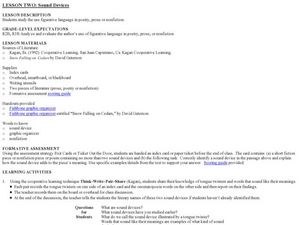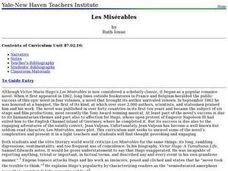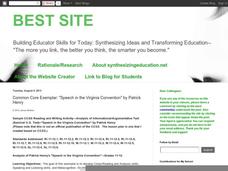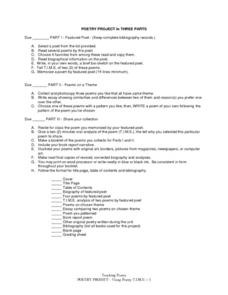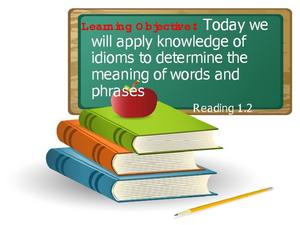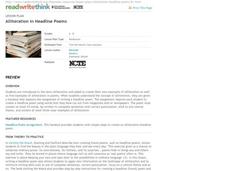Curated OER
Awesome Animals
Sixth graders write descriptive narratives about animals. In this descriptive writing lesson, the teacher models how to write a paragraph with interesting sensory words and exciting verbs. Students choose a picture of an animal they want...
Curated OER
Sound Devices
Students examine the impact of sound devices in poetry, prose, and non-fiction. In this figurative language lesson, students read instructor-selected literature and identify uses of alliteration, repetition, consonance, rhythm, rhyme,...
Curated OER
Les Mis'rables
Students read, understand, and enjoy Les Miserables. They improve their skills in literary analysis, writing, and listening. Through the study of biblical and historical allusions, symbols, metaphors, and other figurative language, they...
Curated OER
Antarctic Similes
For this Antarctic similes worksheet, students review the definition of this type of figurative language and then write 5 similes about Antarctic animals illustrating 1 of them.
Curated OER
Rest in Peace, Maniac Magee
Scholars read Maniac Magee and create epitaphs for each of the major characters using precise words reflecting the individual characters personality and nature. They will learn what an epitaph is and practice writing their own. They can...
Curated OER
Descriptive Writing
Have your class practice using descriptive language in their writing. This resource provides learners with a list of terms and adjectives. For example, one slide shows a picture of a wolf, and then lists descriptions, such as moon howler...
Curated OER
Irony in Poetry and Prose (Fiction and Non-fiction Texts)
Middle and high schoolers examine the impact of irony in poetry and prose. In this figurative language lesson, they read instructor-selected literature and identify uses of irony. Then they discuss how irony enhances literature.
Curated OER
Speech in the Virginia Convention
“. . .different men often see the same subject in different lights. . .” but the great orator Patrick Henry used all the skills at his command to craft a speech to convince listeners to see things as he did--that liberty was worth dying...
Teaching English
Poetry Project in Three Parts
It’s poetry T.I.M.E! Individuals use the T.I.M.E. format (T = Title, thought, and theme; I = Imagery and figurative language; M = music and sound; E = emotion) to study a poet, collect poems that have a similar theme, and create a...
EngageNY
Analyzing Text Structure: “Water Is Life” Paragraphs
Water, water everywhere. Readers revisit paragraphs six through nine in the article "Water is Life" to answer text-dependent questions. They then pair up to reread the article focusing on its structure and record their thoughts on...
Soft Schools
Onomatopoeia in Literature
Identifying onomatopoeia is one thing; making an inference about the significance of the sound is more advanced. Young poets read a literary passage and identify the examples of onomatopoeia in each before naming the source of the sound.
Deer Valley Unified School District
Close Reading: Analyzing Mood and Tone
The AP Literature and Composition exam is all about close reading. Test takers are presented with a passage and asked to analyze how an author uses literary devices to create a desired effect. Prepare your students for the exam with a...
ReadWriteThink
Alliteration All Around
Discover alliteration found in picture books by Pamela Duncan Edwards. Then, dive into a read aloud of Alligators All Around by Maurice Sendak. This practice sets the stage for budding poets to create their own acrostic poem, write an...
Curated OER
Knowledge of Idioms
What is an idiom, and why is it necessary that we know and understand them? This brief PowerPoint helps answer these questions by looking at examples and offering a strategy for reading new text that might contain an idiom. The final...
K12 Reader
Historical Perspective: Two People in History
Open-ended and intriguing, a writing prompt about two people from history is sure to get your young scholars thinking. Have them choose two historical figures, and after brainstorming their similarities and differences, successes and...
Curated OER
Who Am I?
Get to know a person in your class or a famous figure in history. With questions about the person's birthplace, parents, and what they are famous for. A space at the bottom prompts writers to list three things they have learned.
Texas Education Agency (TEA)
Syntax (English II Reading)
Lesson five in the series focuses on syntax and the elements that make sentences enjoyable. Learners practice building different clauses and phrases and using figures of speech and rhetorical and literary devices.
Curated OER
Vivid Verbs
Spice up your writing! Your amateur writers will benefit from concentrating on understanding and improving verb use in writing. An introductory activity addresses weak verbs. A second exercise helps them see the importance of strong...
Curated OER
All Aboard!
Learners recognize and identify onomatopoeia. They will read the book All Aboard! A True Train Story, by Susan Kuklin. After reading the book, they list and illustrate examples of onomatopoeia. Then they write a poem or story using...
Curated OER
Reliving History through Slave Narratives
Helpful for an American literature or history unit, this lesson prompts middle schoolers to examine slavery in the United States. They read slave narratives that were part of the Federal Writers' Project and then conduct their own...
ReadWriteThink
Alliteration in Headline Poems
Poetry is everywhere you look! Create found poems using headlines from newspapers and magazines. Young poetry focus on creating alliterative phrases with words they find in headlines, tying their poems to a central theme.
Lincoln Public Schools
Developmental Strokes: Pre-Writing Worksheet
Young writers develop their fine motor skills one stroke at a time with this simple tracing worksheet. Looking at pictures of eight basic figures ranging from horizontal and vertical lines to circles and triangles, children practice...
Pearson
Langston Hughes
An author study provides learners the opportunity to explore in depth the life of, the influences on, and the works of a single literary figure. Introduce middle schoolers to Langston Hughes with a unit that models how to approach an...
Adult Fiction by Jewell Parker Rhodes
Ghost Boys: Educator Guide
The spirit of the Civil Rights Movement lives on in a more literal than figurative way in Ghost Boys. A focused lesson plan features Jewell Parker Rhodes' novel about ghosts of slain black teenagers, including the main character, Jerome,...
Other popular searches
- Figurative Language Poetry
- Figurative Language in Poems
- Figurative Language Quiz
- Figurative Language Project
- Imagery Figurative Language
- Figurative Language Lessons
- Using Figurative Language
- Figurative Language Worksheets
- Figurative Language Test
- Figurative Language in Poetry
- Figurative Language Vocabulary
- Figurative Language in Prose



